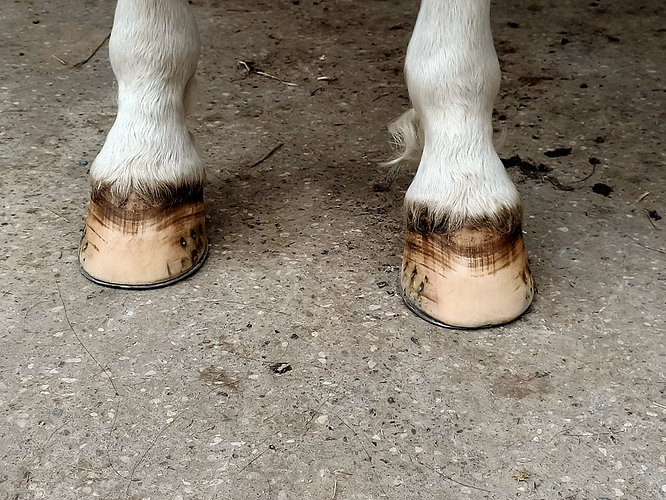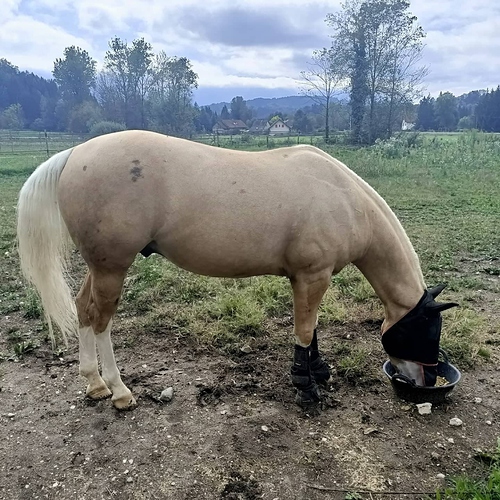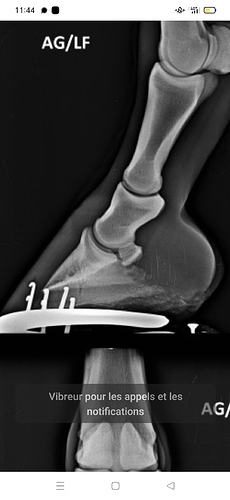Hi, what do you think of how my horse IS shod? Hé s been donne 10 days ago. I feel that thé feet are not the same but i wanted to know what other people think about it and how improve. Tia
Need more views. From the side, and the sole. Each foot separately.
In addition to needing side views, the camera needs to be at ground level, not looking down on the feet. Make sure the line of the lens is perpendicular to the center of the foot, and that ideally, the horse is standing squarely (so all 4 feet are equally weighted), but at the very least that the leg whose foot you’re shooting has a vertical cannon bone.
I agree that you can’t tell much from those photos, but imo those growth/stress lines in the hoof that dip down at the toe are not a good sign about hoof balance. Even just based on those lines I’d be worried about the angle of the coffin bones being too steep.
Is your horse a solid palomino with 4 white stockings or a paint? Cute either way!!!
eta - I deleted the first post because for some reason I couldn’t edit it.
Ok thanks i ll take some other views tomorrow. It IS a quarter horse thanks.
Yes i am concerned, do you think that this stress séen with thé lines Can bé assessed? I Hope it IS not too late to get him right. Hé s a 4 Years old quarter horse
I’m pretty sure that better photos will just show that the trim/balance needs correcting, and this would be something that is easily fixed. Side view photos could even show that it has already been addressed, and that these lines just need to grow out. Horses get these growth/stress lines all the time and they are not a problem as such. Even simple things like a change in feeding or grazing conditions can cause them. I only mentioned them because the shape of them can often give you clues about things like hoof balance. I wouldn’t get too worried.
Is your horse 100% sound?
The rise in the growth rings around the quarters (which is really what’s happening, as opposed to the rings at the toe dipping down, even though that’s what it looks like) almost guarantee the heels are too long and/or the bars are overgrown, both of which lead to increased pressure at the quarters, causing “jamming” and pushing things up
I will take tomorrow some pictures from thé bottom and side
Hé s short striding for 10 days After New shoes, thén, when thé foot grows hé walks normally
This IS him🙂
Sorry, what does jamming and pushing things UP means? Sorry i am french:roll_eyes:
He would benefit from less feed and maybe at least part time in a grazing muzzle. Borderline laminitis symptoms can come and go and he is close to being suspect weight wise. I wouldn’t want him any heavier for his own health.
It sounds like maybe he is being trimmed too short to begin with. A horse should never be sore right after a trim/ shoeing.
He is a pretty boy!
I agree he looks overweight, so that should be addressed.
If he’s chronically sub-clinically laminitic (meaning he has laminitis, but it’s not very obvious) then trimming even to a normal length can make him clinically (visibly) sore, and it takes those 10 days or so for enough foot to grow back to lift his (sore) sole higher off the ground.
OR, your farrier is trimming him too short and putting pressure on the soles, which may be able taking off too much wall but could also be trimming sole that should be left alone.
If you look at the foot from the side, the coronet band should more or less be in a straight line, on a diagonal, from back to front.
If there is excess pressure in the area of the quarters - a bit rearward of center of the side of the foot - then that hoof material will be forced either outward which causes flaring OR causes that hoof material to be pushed upward, which then forces the coronet band upward as well . That’s the jamming/pushing up.
If the foot is flaring, then from the front of the foot, you will see more of a bell shape. Feet should be cone-shaped when viewed from the front - walls forming a straight line, on an angle, from coronet band to ground.
Thanks a lot. Hé s a reining quarter horse. Ok i ll look for his weight but all thé reining horses AT my barn are like him. I did not even immagine hé could bé laminitic, si young?
A good starting place, if you have not done it yet, is to get x-rays and see what angle bones are and how thick or thin the sole is.
That would be the first I would do, have a vet check horse over and determine what is going on in the hoof, then have the farrier address that.
We do that with every new horse, is part of the first vet evaluation, our vet clinic calls it new horse wellness exam, can help knowing what you have and if there are any changes later, you have a starting point.
With a reining bred horse, run 5 panel test, your vet can help:
https://www.aqha.com/-/genetic-test-roundup
If you don’t have one, could help answer the soreness and what to do about it.
Thé rings on thé hoofs could bé laminitis? IS there a treatment ? Now that you talk to me about it, i remember once, After gelding him that i was walking him and hé had an épisode that hé stopped, put his feet foreward and could not move. I brought him to thé vet but hé was very lame on thé left front. Thé vet took x rays and Saïd everything was normal and no laminitis because hé was mostly lame on one front foot. After a few days hé came sound and never knew why hé had that épisode. I suspected laminitis but now that you guys tell me about it i am pretty sûre it was that. Do you think that laminitis could affect more one foot than thé other? Thé shortstriding IS a signé of laminitis? Horse have perfect x rays
Why a 5 panel test would affect short striding? Because of pssm?
Rings on hoof walls mean a physiological change, can be horse ran a fever, changed in management, nutrition or exercise a metabolic change itself, founder one more of several.
Yes, horses can have different levels of PSSM and be affected at some times, not others.
A horse lame for 10 days after shoeing needs to be followed thru, to be sure it is not more than just the shoeing.
My old cushinoid horse in later stages at times was sore for some days after shoeing his front feet, no matter what we tried, other times he was fine.
It seemed to depend on the weather and how soft or hard the ground was, but not always.
I ll do thé 5 panels, did not do because his sire IS 5 négative and thé site of thé mare also. But for pssm it could bé also that a grand parent IS carrier and hé could bé positive. What i mean IS that his sire, pale face dunnit IS 5 négative, hes out of a smart chic olena x reminic mare so even if smart chic IS 5 n/n hé still could bé positive on pssm coming from thé reminic line




